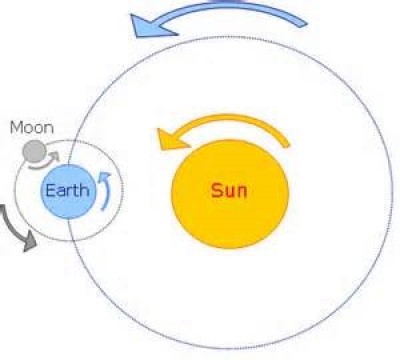Course description
Periodic motion: A motion which repeats itself over and over again after a regular interval of time is referred to as a periodic motion. The motion of moon about the earth, the oscillation of a pendulum, the motion of a mass suspended from a coil spring are the examples of periodic motion (Fig. 1). When a particle, undergoing periodic motion, covers the same path back and forth about a mean position, is said to be executing an oscillatory of vibratory motion. The oscillatory motion is, therefore, a to and fro (forward and backward) motion. One complete to and fro motion is called an oscillation or vibration or a cycle. The time required for each repetition is called time-period. The number of complete oscillations or cycles in unit time is called the frequency of vibration. The displacement of a particle executing an oscillatory motion is usually expressed in terms of sines or cosines or combination of both. Oscillatory motion is also referred to as harmonic motion.
Simple Harmonic Motion (S. H. M.): Let a particle under a force, oscillates along a straight line within some fixed limits, i.e., whenever the force acting on the particle, the acceleration of the particle is proportional to its displacement from its equilibrium position or any other fixed point in its path,
but is always directed in a direction opposite to the direction of the displacement (i.e., directed towards the mean position) and if the maximum
displacement of the particle is the same on either side of the mean position, the particle is said to execute a simple harmonic motion. If a and y be
the acceleration and displacement ofa particle respectively then for simple harmonic motion we get the relation as ; where is a positive constant (Fig. 1 b)
Time Period (Spring-Mass System): Fig. 2 shows a coil spring whose upper end is fixed to a rigid support and a mass m is attached to its free end. Let l be the no-load length of the spring. When the load m is attached to the spring, it hangs in equilibrium with the spring extended by an amount of ∆l. Under this condition the upward force F exerted by the spring (= k ∆l) is equal to the weight of the body, mg. If the spring obeys Hook’s law, then the force on the body is given by F = - k ∆l. Where k is the force constant of the spring and the minus sign simply indicates that the force and displacement are oppositely directed. Since F = mg, ignoring the minus sign, we have, mg = k ∆l.
If the body is now displaced from its equilibrium position and released, it will oscillate along the vertical direction.
Suppose the body is at a distance y below its equilibrium position, then the extension of the spring is (∆l + y). The upward force it exerts on the body is k (∆l + y) and the downward force acting on the body is mg. Hence the resultant force F on the body is
F = mg – k (∆l + y)
= mg – k ∆l – ky
= mg – mg – ky
= - ky.


















